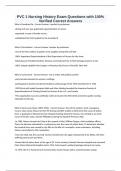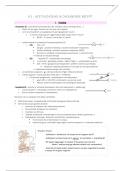PVC 1 Nursing History Exam Questions with 100%
Verified Correct Answers
Who is Dorothea Dix - Correct Answer -teacher by profession
-during civil war was appointed superintendent of nurses
-organized a corps of female nurses
-established the first hospital for the mentally ill
Who is Clara Barton - Correct Answer -teacher by profession
-one of the first civilians to gather army supplies during the Civil War
-1864: Appointed Superintendent of the Department of Nurses for the Army
-following war President Andrew Johnson commissioned her to find missing prisoners of war
-1881: helped establish first chapter of American Red Cross in Danville, New York
Who is Lavina Dock - Correct Answer -was a writer and political activist
-early feminist devoted to women's suffrage
-participated in protest and demonstrations until passage of the 19th Amendment in 1920
-1893 Dock with Isabel Hampton Robb and Mary Nutting founded the American Society of
Superintendents of Training Schools for Nurses of the U.S. and Canada
-This organization was very politically active & became the NLN which promotes quality nursing
education to this day
Who is Clara Louis Maass (1876-1901) - Correct Answer -One of the nation's most courageous
nurses, Clara Louise Maass lost her life during scientific studies to determine the cause of yellow
fever. A graduate of Newark German Hospital Training School for Nurses, she worked as an Army
nurse in Florida, Cuba, and the Philippines during the Spanish-American War.
-In 1900, Maass returned to Cuba at the request of Maj. William Gorgas, chief sanitation officer.
There she became embroiled in a controversy over the cause of yellow fever. To determine whether
the tropical fever was caused by city filth or the bite of a mosquito, seven volunteers, including
Maass, were bitten by the mosquitoes.
-Two men died, but she survived. Several months later she again volunteered to be bitten, this time
suffering severe pain and fever.
-Maass died of yellow fever at the age of 25. In her memory, Newark German Hospital was renamed
Clara Maass Memorial Hospital and in 1952, Cuba issued a national postage stamp in her name.
-In 1976, the U.S. Postal Service honored Clara Louise Maass with a commemorative stamp.
,Mary Eliza Mahoney (1845-1926) - Correct Answer -America's first black professional nurse, Mary
Eliza Mahoney is known not only for her outstanding personal career, but also for her exemplary
contributions to local and national professional organizations
-Mahoney inspired both nurses and patients with her calm, quiet efficiency and untiring compassion
-Today, the Mary Mahoney Award is bestowed biennially in recognition of significant contributions in
interracial relationships.
Who is Helen Fairchild (1885-1918) - Correct Answer -Was a 1913 graduate of Pennsylvania Hospital
Training School in Philadelphia. When the United States entered the World War in 1917 Helen joined
the Pennsylvania Hospital unit as a nurse. These American Expeditionary Force Base Hospitals
included physicians, nurses and dietiticians and six such units from across the country departed for
France in May 1917 to serve with the British Expeditionary Forces
-She herself became a casualty, possibly from the exposure to mustard gas and stresses of combat.
She died following exploratory surgery; the autopsy listed "acute yellow atrophy of the liver," as a
cause of death.
Who is Jane Arminda Delano (1862-1919) - Correct Answer -Was the central figure in uniting the
work of the Nurses' Associated Alumnae (renamed the American Nurses Association in 1911), Army
Nurse Corps, and American Red Cross. From 1909-1912, she served as president of the Nurses'
Associated Alumnae and became superintendent of the Army Nurse Corps
-Perhaps her greatest achievement was helping supply 20,000 professional nurses to meet the needs
of that war. She died in Europe while in wartime service.
-Her motto was "American nurses for American Men"
Who is Mary Breckinridge (1881-1965) - Correct Answer -Introduced a model rural health care
system into the United States in 1925. To provide professional services to neglected people of a
thousand square mile area in southeastern Kentucky, she created a decentralized system of nurse-
midwives, district nursing centers, and hospital facilities. Originally called the Kentucky Committee
for Mothers and Babies, later the Frontier Nursing Service (FNS), the system lowered the rate of
death in childbirth in Leslie County, Kentucky, from the highest in the nation to substantially below
the national average
Who is Susie Walking Bear Yellowtail (1903-1981) - Correct Answer -While working with the then
Indian Health Service from 1929 to1931, Susie Walking Bear Yellowtail helped to bring modern
health care to her own people and to end abuses in the Indian health care system, such as the
sterilization of Native American women without their consent.
-From 1930 to 1960, the Montana nurse traveled throughout North American reservations to assess
the health, social and educational problems Native Americans faced.
, -One of her assessment's revealed that acutely ill Native American children were literally dying on
the backs of their mothers, who often had to walk 20 to 30 miles to get to one of the five hospitals
that served 160,000 Navajo.
What is the concept of "nurse" - Correct Answer care of others
What is the History of Nursing - Correct Answer -Art- "know how"
-Science "know that
-Young profession-old art
What are two things that impact the role of nursing in any society - Correct Answer -the status of
women in society=Status of nurse
-War- increased need=elevated status
Explain Early Tribal society - Correct Answer -Health affected by good and bad spirits
-Spiritual leader became the "shaman" or medicine man
-Care giving fell to females in the family of the ill person
Explain Early Civilizations - Correct Answer -Temples became the center of medical care (male
attendants)
-Priests became physician
-Nursing by slaves, priests in training, or in home
-Documented in Hindu cultures, Egypt, Greece, Rome, Babylon
-Evidence of a combination of prayer and medical practices were used
Explain the Impact of Christianity - Correct Answer -Middle ages 400-1500 C.E.
-Value of compassion and women develops
-Nursing becomes a formally organized profession with "Deaconesses"
-Organized visits to the ill
-Christianity thrives=Nursing thrives
-542 C.E. hospital Hotel Dieu in Lyons, France is established





